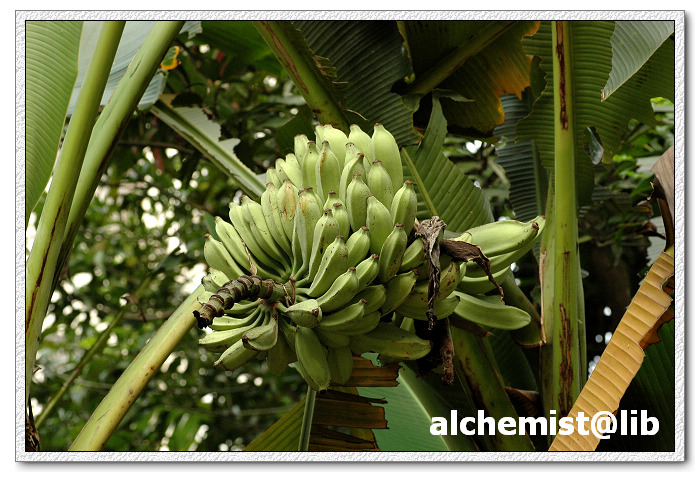- Scientific Name: Musa × paradisiaca L.
- Ref: Sp. Pl.:1043. 1753
- Synonym: Musa × sapientum L.
- English Common Name: cooking banana, cooking plantain, dessert banana, green banana
- Chinese Common Name: 大蕉 dàjiāo, 粉蕉 fěnjiāo
- Japanese Common Name: プランテン puranten
- Family: Musaceae
- Genus: Musa
- Distribution: Cultivated. Fujian, Guangdong, Guangxi, Hainan, Taiwan, Yunnan [native to tropical Asia, widely cultivated in the tropics].
- Photo: 06/21/2009, South China Botanical Garden, Guangdong
Pseudostems clumped, pruinose, 3--7 m. Leaves erect or ascending; petiole pruinose, more than 30 cm, margin closed; leaf blade adaxially deep green, abaxially light green and distinctly pruinose, oblong, 1.5--3 m × 40--60 cm, base subcordate to auriculate, subsymmetric, apex acute. Inflorescence pendulous; rachis glabrous. Bracts adaxially deep red, abaxially purple, ovate to ovate-lanceolate, 15--30 cm or more, deciduous. Flowers in 2 rows in each bract; male flowers with tepals yellow to pale yellow. Compound tepal 4--6.5 cm; free tepal suborbicular to oblong, ca. 1/2 as long as compound tepal, waxy, apex acuminate or rolling into a sac. Infructescence with 7 or 8 clusters of berries. Berries erect or slightly curved, oblong, 10--20 cm, angled; pulp sweet or sweet and acidic, not very fragrant; stalk elongate. Seeds absent or few. 2 n = 33. (Flora of China)
